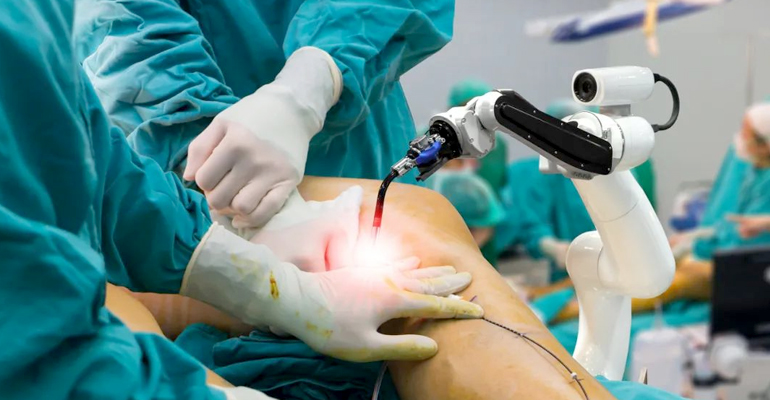-
-
+91-8591556577
-
Robotic Knee Replacement Surgery

Robotic Knee Replacement Surgery
Robotic knee replacement surgery is an advanced procedure that combines the precision of robotic technology with the expertise of a skilled surgeon. This minimally invasive technique allows for greater accuracy in aligning and positioning the knee implant, which can lead to better outcomes, faster recovery, and longer-lasting results. Robotic knee replacement is an excellent option for patients suffering from severe knee pain and mobility issues due to arthritis or injury.
What is Robotic Knee Replacement Surgery?
Robotic knee replacement surgery uses state-of-the-art robotic systems to assist the surgeon in planning and performing the procedure. The surgeon remains in control throughout the surgery, but the robotic arm enhances the precision by helping to make exact cuts and alignments. This level of accuracy ensures the proper placement of the knee implant, which is crucial for the long-term success of the surgery.
When is Robotic Knee Replacement Surgery Needed?
Robotic knee replacement surgery is typically recommended for patients with:
- Severe Osteoarthritis: When the cartilage in the knee joint has worn away, causing bones to rub against each other, leading to pain, swelling, and reduced mobility.
- Rheumatoid Arthritis: An inflammatory condition that damages the knee joint, causing chronic pain and stiffness.
- Post-Traumatic Arthritis: Arthritis resulting from a knee injury that leads to long-term joint damage and pain.
- Failed Knee Surgery: In cases where a previous knee surgery did not achieve the desired results or when an existing knee replacement has failed.
If nonsurgical treatments such as physical therapy, medications, or injections no longer provide relief, robotic knee replacement surgery may be the most effective option to restore mobility and alleviate pain.
Benefits of Robotic Knee Replacement Surgery
Robotic knee replacement offers several key advantages over traditional knee replacement surgery:
- Greater Precision: The robotic system allows for highly accurate cuts and implant placement, reducing the risk of misalignment and improving the overall function of the knee joint.
- Personalized Surgical Plan: Before surgery, the robotic technology creates a 3D virtual model of the patient's knee, allowing the surgeon to plan and customize the procedure based on the patient’s unique anatomy.
- Minimally Invasive Approach: Robotic assistance can lead to smaller incisions, less damage to surrounding tissues, and reduced blood loss during surgery.
- Faster Recovery: With greater precision and less trauma to the tissues, patients often experience quicker recovery times, allowing them to return to their normal activities sooner.
- Longer-Lasting Results: Proper alignment and placement of the knee implant can enhance the longevity of the prosthesis, reducing the risk of complications or the need for revision surgery.
How Robotic Knee Replacement Surgery Works
The robotic knee replacement procedure generally involves these steps:
- Preoperative Planning: Before surgery, advanced imaging (such as a CT scan or MRI) is used to create a detailed 3D model of the patient’s knee. This model helps the surgeon plan the procedure with precision, tailoring it to the patient’s specific anatomy.
- Intraoperative Guidance: During the surgery, the robotic system provides real-time data and feedback, guiding the surgeon’s instruments to ensure precise cuts and implant positioning. The robotic arm assists the surgeon in performing the procedure with unmatched accuracy.
- Postoperative Care: After the surgery, patients will follow a personalized rehabilitation program to regain mobility, strength, and flexibility.
Types of Robotic Knee Replacement Surgery
- Total Knee Replacement (TKR): In this procedure, the entire knee joint is replaced, including the femur (thigh bone), tibia (shin bone), and sometimes the patella (kneecap).
- Partial Knee Replacement (PKR): For patients with damage limited to one part of the knee, a partial knee replacement may be performed, preserving more of the natural knee joint. Robotic technology allows for precise targeting of the affected area, leaving healthy tissues intact.
Recovery After Robotic Knee Replacement Surgery
While recovery time can vary depending on the patient’s health and the extent of the surgery, robotic knee replacement often leads to faster recovery compared to traditional methods:
- Hospital Stay: Most patients can expect to stay in the hospital for 1 to 3 days, depending on their progress.
- Physical Therapy: Rehabilitation begins shortly after surgery to help restore strength, flexibility, and range of motion. The precision of the robotic system may result in a quicker return to normal activities.
- Home Recovery: Patients typically continue physical therapy at home or in an outpatient setting for several weeks. Following the recommended exercises is essential for a successful recovery.
- Full Recovery: Most patients experience significant improvement in pain relief and mobility within 3 to 6 months, with full recovery potentially taking up to a year.
Risks and Complications
Although robotic knee replacement is generally safe, it does carry some risks, including:
- Infection at the surgical site
- Blood clots
- Implant loosening or wear over time
- Nerve or blood vessel damage
- Persistent stiffness or pain
However, with robotic precision and careful postoperative care, the risk of complications is minimized, and most patients experience excellent outcomes.
Why Choose Us for Robotic Knee Replacement Surgery?
- Cutting-Edge Technology: We use the latest robotic systems to ensure optimal precision and personalized care for each patient.
- Experienced Surgeons: Our orthopedic surgeons are highly trained in robotic-assisted procedures, providing patients with the highest level of care and expertise.
- Comprehensive Rehabilitation: Our rehabilitation programs are tailored to help patients recover quickly and return to their daily activities with improved mobility and function.
